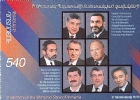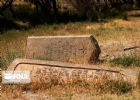
English :
06 Ağustos 2021
![]()
![]()
![]()
Hagop Baronian: Armenian Ottoman satirist of 19th-century Istanbul - 
A talented journalist who published the first Turkish humor magazine in the Ottoman Empire, Hagop Baronian was also an important playwright in the Ottoman and Armenian theater known as the 'Moliere of Armenians'
It has been more than a century since the death of sharp-tongued satirist Hagop Baronian. However, the literary works of the Armenian Ottoman journalist, playwright and humorist still offer readers a perspective into everyday life in 19th-century Istanbul.
Publishing his first play at just 22 years old, Baronian's works are relatively few in number but their impact was great, dealing with issues such as marriage and family matters. The products of his journalistic career were likewise pertinent to the times, containing satire and social criticism.[The literary works of Hagop Baronian offer an insight into everyday life in 19th-century Istanbul.
Born in 1843 to a poor family in the city of Edirne in present-day northwestern Turkey, he predominantly went to Armenian schools, although he attended a Greek school for about a year where he learned to speak Greek.
In 1864, he settled in Istanbul, then the capital of the Ottoman Empire, where he worked in various jobs as a secretary and teacher, learning Italian and French through his own efforts along the way.
Here he also started contributing to various journals, gaining experience as a professional writer.
Professional life
Baronian's interest in theater manifested at a very young age. His first play, written in 1865, was a short farce called “One Butler with Two Masters,” an imitation of Italian playwright Carlo Goldoni's original work, “A Butler with Two Masters.”
Four years later came his first comedy, “Oriental Dentist,” in which he dealt cheerfully with arranged marriages and marital fidelity.
Baronian explored what he saw as decaying family relations, with couples going behind each other's back, while the lives of spouses and lovers old and new intertwine.
Amid a background of the social developments of the period, the play invites readers to think about the timeless relationship between marriage and fidelity.
"He began writing another play, “Flattery,” in 1872. However, this would only be completed half a century later by fellow great Armenian Ottoman humor writer Yervant Odian after it was left unfinished.
Another satire, “Honorable Beggars,” published in 1880-1881, focused on the indiscretion and naivety of a rural notable, while also drawing attention to how open these qualities were to exploitation by an array of artistic, professional, religious and artisanal opportunists.
His last work, "Baghdasar Aghbar,” again criticized Armenian institutions around the theme of divorce. It is one of the most popular plays in the Armenian comedy tradition.
Though he announced in 1887 that he would be releasing another comedy called "Dowry," he never published this comedy. An incomplete draft of the play, consisting of eight scenes and some episodes, was found among his papers and published following his death.
Journalism
Baronian's career in journalism began in 1871 when he became chief writer at Yeprad (Euphrates) newspaper, later also writing in the Megu (Bee) and Khigar (Wise).
He started publishing an Ottoman Turkish humor magazine, known as Tiyatro, on March 20, 1874, followed only a couple of weeks later by Tadron, a bilingual publication in both Armenian and Ottoman Turkish, which was first printed in the Armenian alphabet.
Baronian created all of the content published in the four-page Tiyatro magazine. The biweekly was the fourth Turkish satirical magazine published in the Ottoman Empire.
In Tadron, he discussed issues relevant to the Armenian community at the time. It was also published twice a week and included common content with Tiyatro, with both publications surviving until 1877.
Baronian died of tuberculosis on May 27, 1891, in Istanbul. He is buried in the Armenian cemetery in the city, though his exact place of rest remains unknown.
None of his plays were staged while he was alive, though they became popular in the decade following.
Known by many as Moliere of the Armenians, Baronian shines a light on contemporary social life in his city and his works have proven invaluable to interested historians and laypeople alike.
It has been more than a century since the death of sharp-tongued satirist Hagop Baronian. However, the literary works of the Armenian Ottoman journalist, playwright and humorist still offer readers a perspective into everyday life in 19th-century Istanbul.
Publishing his first play at just 22 years old, Baronian's works are relatively few in number but their impact was great, dealing with issues such as marriage and family matters. The products of his journalistic career were likewise pertinent to the times, containing satire and social criticism.[The literary works of Hagop Baronian offer an insight into everyday life in 19th-century Istanbul.
Born in 1843 to a poor family in the city of Edirne in present-day northwestern Turkey, he predominantly went to Armenian schools, although he attended a Greek school for about a year where he learned to speak Greek.
In 1864, he settled in Istanbul, then the capital of the Ottoman Empire, where he worked in various jobs as a secretary and teacher, learning Italian and French through his own efforts along the way.
Here he also started contributing to various journals, gaining experience as a professional writer.
Professional life
Baronian's interest in theater manifested at a very young age. His first play, written in 1865, was a short farce called “One Butler with Two Masters,” an imitation of Italian playwright Carlo Goldoni's original work, “A Butler with Two Masters.”
Four years later came his first comedy, “Oriental Dentist,” in which he dealt cheerfully with arranged marriages and marital fidelity.
Baronian explored what he saw as decaying family relations, with couples going behind each other's back, while the lives of spouses and lovers old and new intertwine.
Amid a background of the social developments of the period, the play invites readers to think about the timeless relationship between marriage and fidelity.
"He began writing another play, “Flattery,” in 1872. However, this would only be completed half a century later by fellow great Armenian Ottoman humor writer Yervant Odian after it was left unfinished.
Another satire, “Honorable Beggars,” published in 1880-1881, focused on the indiscretion and naivety of a rural notable, while also drawing attention to how open these qualities were to exploitation by an array of artistic, professional, religious and artisanal opportunists.
His last work, "Baghdasar Aghbar,” again criticized Armenian institutions around the theme of divorce. It is one of the most popular plays in the Armenian comedy tradition.
Though he announced in 1887 that he would be releasing another comedy called "Dowry," he never published this comedy. An incomplete draft of the play, consisting of eight scenes and some episodes, was found among his papers and published following his death.
Journalism
Baronian's career in journalism began in 1871 when he became chief writer at Yeprad (Euphrates) newspaper, later also writing in the Megu (Bee) and Khigar (Wise).
He started publishing an Ottoman Turkish humor magazine, known as Tiyatro, on March 20, 1874, followed only a couple of weeks later by Tadron, a bilingual publication in both Armenian and Ottoman Turkish, which was first printed in the Armenian alphabet.
Baronian created all of the content published in the four-page Tiyatro magazine. The biweekly was the fourth Turkish satirical magazine published in the Ottoman Empire.
In Tadron, he discussed issues relevant to the Armenian community at the time. It was also published twice a week and included common content with Tiyatro, with both publications surviving until 1877.
Baronian died of tuberculosis on May 27, 1891, in Istanbul. He is buried in the Armenian cemetery in the city, though his exact place of rest remains unknown.
None of his plays were staged while he was alive, though they became popular in the decade following.
Known by many as Moliere of the Armenians, Baronian shines a light on contemporary social life in his city and his works have proven invaluable to interested historians and laypeople alike.
Bu haber sabahdaily kaynağından gelmektedir.
Haber metninde yer alan görüşler haber kaynağı (sabahdaily) ve yazarına ait olup,
bolsohays.com sitesi haber hakkında herhangi bir görüş üstlenmemektedir.
Opinions expressed are those of the author(s)-(sabahdaily). They do not purport to reflect the opinions or views of bolsohays.com
Diğer Haberler
-
Photography of Ancient Armenia Featured in New 2026 Wall Calendar
-
Pope asks for prayers ahead of visit to Türkiye and Lebanon
-
Armenia will step up its efforts toward membership in the European Union in 2026
-
Economy Minister discussed rebranding of Armenian brandy with producers
-
Aleppo - Yerevan - Aleppo
-
Mirzoyan: Armenia citizens should live in Armenia, Azerbaijan citizens should live in Azerbaijan
-
Armenia will officially receive the European Union`s visa liberalization action plan in the coming
-
Armenia might achieve visa-free travel to the European Union within two years
-
Armenia opens transit route between Azerbaijan and Türkiye
-
Armenia invites Erdogan, Aliyev to 2026 European Political Community Summit
-
Patrick Fiori to Compete in Eurovision 2027?
-
Armenian Wines Voskevaz Karasi Areni Noir And Haghtanak Win Gold at Prestigious U.S. Wine Competitio
Foto Galeri Tüm Galeriler
Video Galeri Tüm Videolar
-

Papa XIV. Leo`nun Türkiye Ziyareti | Volkswagen Arena Efkaristiya Ayini
-

Parliament Shooting in Armenia, October 27, 1999
-

Albert - Brave Heart | ???????? Armenia | Official Music Video | Junior Eurovision 2025
-

Սրբադասման Սուրբ Պատարագ եւ Հրեշտակ Տեառն Մարեմեան աղօթք 19 հոկտեմբեր 2025 – Լեւոն ԺԴ. Քահանայապետ
Anket Tüm Anketler
Günün Sözü
Մաքուր, համեստ եւ պարկեշտ նկարագրի տէր մարդը յաղթական մըն է, իսկ թոյլ բարոյականի տէրը, աննկարագիր մարդը պարտուած մըն է կեանքի պայքարին մէջ։














